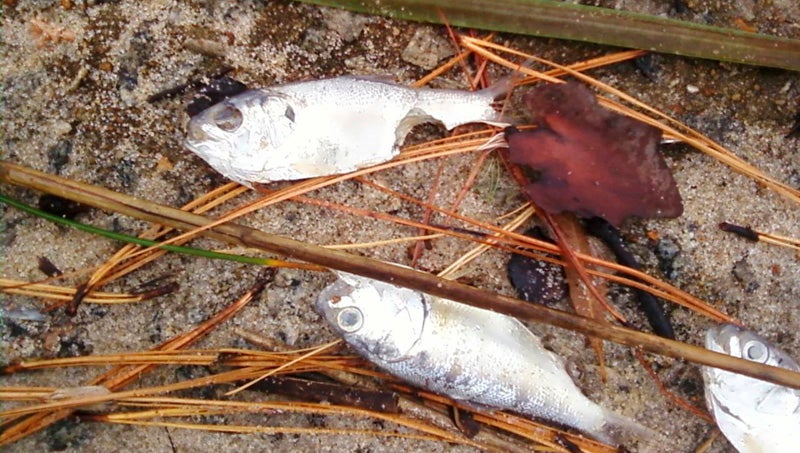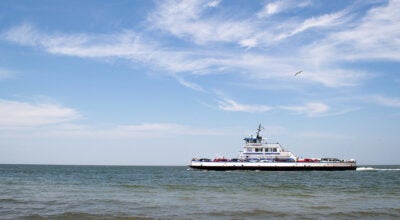Senate budget calls out Pamlico River pollution strategy
Published 6:40 pm Friday, June 3, 2016

- REVIEW AND REVISION: The Senate budget includes a provision that specifically calls for review and/or revision of the Tar-Pamlico River Nutrient Sensitive Waters Management Strategy, which 20 years ago set up rules requiring municipalities, developers and agricultural entities to manage runoff into local waterways.
Algal blooms. Massive fish kills. In the mid-1990s, the N.C. Department of Marine Fisheries referred to the Pamlico River as “commercially dead,” unable to support fulltime commercial fishermen. In the past two decades, the health of the river has taken a turn for the better, but legislation in the Senate’s version of the North Carolina budget has many wondering if the future health of the river will once again be at risk.
The Senate passed its version of the 2016-17 state budget on Friday in Raleigh. Along with programs for the Neuse River Basin, the Falls Lake watershed and Jordan Lake watershed, a provision specifically calls for review and/or revision of the Tar-Pamlico River Nutrient Sensitive Waters Management Strategy, which 20 years ago set up rules requiring municipalities, developers and agricultural entities to manage runoff into local waterways. The budget calls for review and revision of those rules starting in December, and full repeal in December 2019.
According to the bill, the nutrient management programs don’t work.
“Existing nutrient management strategies have shown little to no improvement in water quality and have created an increased regulatory and economic burden in the billions of dollars to the state, its municipalities, and its citizens, and have rendered thousands of acres of public and private property useless,” the provision reads.
The Senate budget also describes current programs as “flawed, economically irresponsible and scientifically unjustified” and calls for development of a new statewide management strategy with emphasis on research of methods treating already nutrient-laden water.
Many who recall the Pamlico River and other eastern North Carolina waterways of the past are questioning the wisdom of the bill’s provision.
THE HISTORY
In the late 1980s to the late 1990s, eastern North Carolina waterways were in a state of emergency. During that time, algal blooms took over entire rivers, leading to massive fish kills caused by A. invadans, a slime mold causing ulcerated sores. The blue crab population, one of the state’s most prolific fisheries, was also being decimated by a shell disease, according to Jess Hawkins, former executive assistant to the director of North Carolina Division of Marine Fisheries.
Researchers discovered that in 1997 alone, the toxic dinoflagellate Pfiesteria was responsible for killing more than a billion fish in 48 separate outbreaks in the Albemarle-Pamlico Estuarine System, the second largest estuary in area in the U.S. and the most important fish nursery ground on the Atlantic coast, according to a 1997 study by Joann M. Burkholder and Howard B. Glasgow, both professors and researchers with the Center for Applied Aquatic Ecology at North Carolina State University. Exposure to the toxic Pfiesteria wasn’t limited to aquatic species — it was found to impact the human nervous system, with symptoms including blurred vision, burning skin and eyes, acute respiratory difficulty, muscle cramping, nausea, vomiting, severe headaches and profound memory dysfunction. During their studies, N.C. State researchers also discovered Pfiesteria was directly stimulated by inorganic plant nutrients such as nitrate and phosphate, which are found in cropland or lawn fertilizers and other sources — runoff from the land.
Water quality was at such a low that then-Governor Jim Martin took action.
“Back in the 1980s and early ’90s, things were so bad that Gov. Martin created a rapid response team. There were four individuals — two from Marine Fisheries and two were from Division of Environmental Management (now Division of Water Resources) — to respond to events. The public was so concerned about the fish kills, the dinoflagellates, the Pfiesteria, a shell disease in blue crabs, (because) the catches had been declining,” said Hawkins, who was assigned to the task force.
Addressing the severity of the issue, Martin requested a meeting with the board of Pamlico-Tar River Foundation (now Sound Rivers) and with local crabbers to discuss what could be done, Hawkins said.
Texas Gulf (now PotashCorp-Aurora), the phosphate mining company on the south side of the Pamlico, got on board and began working with state officials to reduce the amount of fluoride and phosphate entering the river, Hawkins said. Stakeholders also began working on nutrient management strategies for municipalities, landowners and agricultural entities, and the strategies passed into law were the outcome of a decade of those stakeholders’ meetings — meetings in which compromise was a key element, according to Heather Jacobs Deck, Pamlico-Tar riverkeeper.
Of particular focus was reducing the amount of nitrogen and phosphate in runoff. The elements were known to cause algal blooms which, in turn, lower the amount of oxygen in the water, allowing slime molds like A. invadans to prey on juvenile and other vulnerable fish, as well as lead to the proliferation of Pfiesteria.
“During that time, we had evidence that 80 percent of the different types of the fish that occur in the river had A. invadans sores on them,” Hawkins said.
THE COST
The measures to reduce nitrogen- and phosphate-laden runoff into the waterways came with a price. Adam Waters, Washington’s Water Resources superintendent, has been with the department for 25 years and was instrumental in creating the city’s nutrient management program mandated by the state.
“To start with, the City of Washington did not have a stormwater program at the time when the Tar-Pam rules came down the pipe,” Waters said. “We were one of the smallest communities that those rules were going to affect. … Our big argument was that it was going to create a financial burden (for the city) and development in the city — it was going to discourage economic growth in the City of Washington,” Waters said.
Meetings between city officials and local legislators did not have the desired results, he said.
“We ended up having to develop a program and write a program and hire staff to run the program,” Waters said. “We set rules in place so that if people build in the City of Washington, they were going to have to treat stormwater runoff that was going to be created on impervious surfaces.”
Waters said the nutrient management rules definitely increased the cost of commercial development in the city, as retention ponds designed to capture runoff from impervious surfaces now must be treated for nitrogen and phosphate, but it’s not possible to determine if Washington’s economy has been negatively impacted.
“It’s kind of hard to quantify whether that affected the economic growth of the city or if it was the downturn of the 2008 economy,” Waters said. “The City of Washington does not grow at a rapid pace, so it’s hard to say that did affect economic growth.”
THE RESULTS
Hawkins said water quality now, as opposed to the decade between the late-1980s and late-1990s, has improved dramatically and is the result of all the measures being taken to reduce the impact of nutrient runoff into the waterways.
“It is my belief that it has slowed those cumulative impacts down,” Hawkins said. “But it’s hard for the state to measure cumulative impacts.”
Waters agrees with the assessment.
“It’s hard to quantify that,” Waters said. “Of course, the intent of the rule is to reduce the nitrogen and phosphate in the river. Every pound that we can take out is ultimately going to help the river and the estuary. To what degree, I don’t know, but every pound that we can prevent from getting to the river is going to help the river and estuary.”
Hawkins said blue crab shell disease has diminished in the past two decades, if not altogether disappeared, and algal blooms causing fish kills on the scale of past are rare.
“Before we put in the nutrient restrictions, some of the Neuse River was completely green and Chowan River was completely green (with algae),” Hawkins said. “Now the waters don’t turn as green as often, or at all.”
THE SENATE BUDGET
The Senate budget claims the nutrient management programs in place do not work, and to a certain degree, the claim is correct — one has to look no further than experimental programs put in place for the Falls Lake and Jordan Lake watersheds, suppliers of drinking water to Raleigh and Durham, according to Deck. Resistance to comply with rules addressing nutrient runoff by government and developers in those areas has led to a 10-year stalemate, in which none of the measures have been put in place, she said.
Instead, in-water treatment of pollutants has been attempted with very little success, most noticeably with the failed SolarBees experiment on Jordan Lake. The solar-powered, floating turbines were designed to stir water, promoting oxygenation and theoretically improve water quality decimated by algal blooms.
In a May press release, Department of Environmental Quality Secretary Donald van der Vaart announced the project would be discontinued, “after reviewing nearly two years of scientific data that show it will not yield the intended results.”
After more than $1 million invested in the project, with another $1.5 million approved by the General Assembly last fall, the Senate budget puts an official end to the SolarBees program and allocates the remaining funds to the state’s Clean Water Management Trust Fund. From the trust fund, University of North Carolina-Chapel Hill will receive $500,000 to study nutrient management strategies, including in-water treatment, and Wildlife Resources Commission will receive another $500,000 to study freshwater mussels, part of which will be dedicated to “assess strategies for use of freshwater mussel species in impaired water bodies in the State, including Jordan and Falls Lakes.”
Deck said the Tar-Pamlico River and Neuse River nutrient management rules have been lumped in with the failed programs of Jordan Lake and Falls Lake watersheds with no cause, because the Tar-Pamlico rules have increased water quality.
“The premise that they’re basing this on is ‘These rules don’t work,’ and that’s just patently not true,” Deck said.
The Senate budget calls for public hearings to take place in areas both upstream and downstream of impacted river basins and subbasins and for a stakeholders group to convene no later than Dec. 31 of this year.
According to Senator Bill Cook, who represents Beaufort County, the process outlined in the Senate budget will identify and review all relevant nutrient management rules in order to ultimately create better policies.
“We have much more water quality data than we did 10-20 years (ago) when some of these strategies were developed. Some of these data also show that, in many places, certain rules are not making any improvements in water quality (while still costing local governments and private landowners money for naught). Therefore, because a review and re-adoption was already set to begin, this provision slows that process down and provides more resources and time to reconsider what policies are working and what policies are not working and compiling recent water quality data (that was unavailable when original policies were drafted) as well as reviewing new technologies (similar to a successful in-water mitigation project currently occurring in Durham) to develop an approach that actually works,” Cook stated in an email.
Cook declined to comment about whether he believes the Tar-Pamlico Nutrient Sensitive Waters management rules have been successful.
Deck has no such qualms. She believes the measures of the past have vastly improved water quality and quality of life for everyone who enjoys the river. She also believes that the Senate budget is not the place to address the nutrient management programs.
“Part of the argument is that these are substantial policy decisions you’re making and you’re sticking it in the budget. It’s not an appropriate venue to do this. It’s not an actual way to have a real discussion,” Deck said. “If you want to talk about the rules, we’ll be happy to do that.
“Our members and board members of the Pamlico-Tar River Foundation were instrumental in supporting and passing these protections for the Tar-Pamlico River,” Deck wrote in an email. “To do away with these protections without any meaningful discussion beforehand is bad policy, bad governing and bad for all of those that live along and use the Tar-Pamlico River.”
Deck said the potential impact of doing away with or lessening nutrient management requirements could lead to a return to past water quality issues.
“Do they really want to go back to those days? Because if they do this, they have started the ship on a course that will lead to more algal blooms, more fish kills, less safe environment to swim in, less fish and overall a poorer quality of life that comes with polluted water. And we’ll have no choice but to fight back in any and every way we know.”





